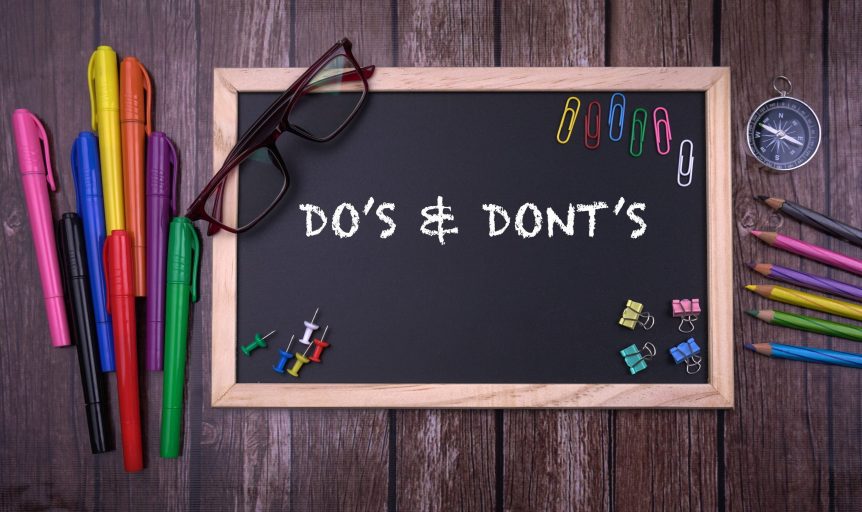24 Do’s and Don’ts for Creating E-Learning Courses
E-learning can benefit your business’s training strategy in a range of different ways, from lowering costs to improving the quality of your training to making training more responsive to the needs of your business.Just deciding you will use e-learning as a training delivery method is not enough, however. You need to make sure your e-learning courses as good as possible. To help with this, here some things you should do and some you should avoid.
The Main Do’s and Don’ts of E-learning
- Do: Assess Learner Needs
You need to understand your learners, the differences between learners, and what motivates them. It’s also important to understand the business expectations of learners. For example, what behavioural changes does your business require?
- Don’t: Expect to Find a One-Size-Fits-All Solution
E-learning delivers the best results when the subject matter is highly focused. Therefore, don’t expect to find an e-learning course structure that will deliver on all your training requirements.
- Do: Present Content in Small, Bitesize Chunks
E-learning content works best when it is delivered in small chunks, i.e., where the learner can go through a section in minutes rather than having to find large blocks of time to complete training.
- Don’t: Use Lots and Lots of Text
How you present e-learning content has an impact on the above point as well as on learner engagement. Sections that have lots of text rarely work.
- Do: Use a Range of Different Visuals
Following on from the above, replace large blocks of text with visuals – images, videos, infographics, charts, etc.
- Don’t: Add Images for the Sake of Adding Images
You can go overboard with images, particularly when they are added simply for decoration. All images should have a learning purpose.
- Do: Aim for an Informal, Friendly Tone
Formal and stuffy language is unlikely to appeal to learners, and it will not engage them with the e-learning course. In most situations, a conversational tone works best.
- Don’t: Try to Make the Course Something It’s Not
Don’t try to be something you’re not: this is a good phrase to remember when creating e-learning content. Authenticity is very important.
- Do: Make the Content Relevant to Learners
Learners will engage with content they can relate to and that fits in with their day-to-day experience.
- Don’t: Ignore the Importance of Testing
You need to test the relevancy of your content along with all other aspects of the course, i.e., does everything work, do learners understand the navigation, etc.
- Do: Ensure Design Consistency
Each screen and element in your e-learning course should be consistent, and the overall design should be consistent with your brand.
- Don’t: Focus on Design Over Content
While design is important, e-learning is about content, first and foremost. So, never substitute content for good design.
- Do: Include Interactive Elements
Interactive elements, such as quizzes and scenarios, will improve the learning process and engagement levels.
- Don’t: Make Questions or Scenarios Too Easy
E-learning courses are about learning, not about getting the right answer to every question. So, challenge your learners.
- Do: Ensure Your Course Can Be Accessed on Any Device
One of the reasons e-learning is such a powerful tool is that learners can proceed through your courses wherever they are and whenever they have time. You need to facilitate this by ensuring the course works on all devices.
- Don’t: Forget About Speed & Performance
This tip particularly applies when learners use mobile devices on the go.
- Do: Include Key People in the E-Learning Development Process, Including Managers
Getting buy-in from as many people as possible will improve engagement levels with your course. Managers, supervisors, and other key individuals should understand the benefits of the course and why you are creating it, and they should have the opportunity to provide input.
- Don’t: Let Schedules Slip
Following on from the above, the more people involved, the more complicated the process can take. So, let people contribute, but don’t let them take over. Instead, stick with your schedule and focus on the training.
- Do: Assess the Performance of Your Course and Ask for Feedback
Even the best e-learning courses can be improved, so get feedback from wherever you can.
20: Don’t: Let Material Become Stale
The best e-learning courses are constantly updated with new information when it becomes available. Replacing outdated content is essential.
21: Do: Localise the Content Where Appropriate
Localising content will help improve understanding, you will avoid offending some learners, and it will help with engagement.
22: Don’t: Go Overboard with Local or Cultural References
Whether you are localising your content or not, local or cultural references often backfire. They can be misunderstood, for example, or they can go out-of-date.
- Do: Make Sure the Course is As Professional as Possible
Most employees in the UAE and Saudi Arabia have high expectations for e-learning, so you need to make your courses as professional as possible.
- Don’t: Attempt to Do It Yourself If You Don’t Have the In-House Skills
The above point can be difficult to achieve if you don’t have the required resources in-house. Hiring a professional e-learning developer more often than not improves return on investment.
Adapting to E-Learning
Creating e-learning courses is different from creating other types of training or training materials. In many respects, there is more you need to consider. The payback, though, is improved results and return on investment.
As mentioned earlier, however, good training results and an improved return on investment won’t simply happen because you create and launch an e-learning course. Instead, you will get the results your business needs by optimising each part of your course with a focus on your training and business goals.
